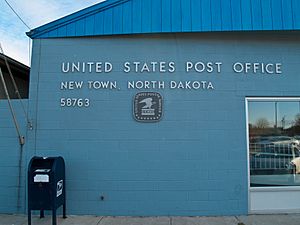New Town, North Dakota facts for kids
Quick facts for kids
New Town, North Dakota
|
|
|---|---|

Post office in New Town
|
|

Location of New Town, North Dakota
|
|
| Country | United States |
| State | North Dakota |
| County | Mountrail |
| Founded | August 1950 |
| Area | |
| • Total | 2.89 sq mi (7.48 km2) |
| • Land | 2.89 sq mi (7.48 km2) |
| • Water | 0.00 sq mi (0.00 km2) |
| Elevation | 1,926 ft (587 m) |
| Population
(2020)
|
|
| • Total | 2,764 |
| • Estimate
(2022)
|
2,645 |
| • Density | 957.06/sq mi (369.58/km2) |
| Time zone | UTC-6 (Central (CST)) |
| • Summer (DST) | UTC-5 (CDT) |
| ZIP code |
58763
|
| Area code(s) | 701 |
| FIPS code | 38-56740 |
| GNIS feature ID | 1036184 |
| Highways | ND 23, ND 1804 |
New Town is a city in Mountrail County, North Dakota. In 2020, about 2,764 people lived there. This makes it the 18th largest city in North Dakota.
New Town was created in 1950. It was built for people from the towns of Sanish and Van Hook. These towns were going to be covered by water when Lake Sakakawea was made. Lake Sakakawea is a large lake formed by a dam.
New Town is the biggest city and main center of the Fort Berthold Reservation. It is also home to Nueta Hidatsa Sahnish College. You can find New Town on State Highway 23, where the Four Bears Bridge crosses Lake Sakakawea.
Contents
History of New Town
Building the Garrison Dam
In 1944, the United States government decided to build the Garrison Dam. This dam was planned to be the biggest earth-filled dam in the world. It would create a huge lake, called Lake Sakakawea. This lake would be about 200 miles long and 14 miles wide in some spots. It would have about 1,500 miles of shoreline.
The lake was needed to help with irrigation and provide water for the area. But to build it, several towns had to be moved. These towns included Sanish, Elbowoods, Lucky Mound, and Van Hook. Their residents had to find new homes before the land was flooded.
Creating a New City
Officials looked at seven different places before choosing the spot for New Town. Once the land was bought, plans for the new city were made quickly. Army engineers helped to map out the town by August 1950.
On September 10, 1950, a special ceremony was held to start building New Town. A road grader cut the first line in what would become Main Street. The first building was for the company helping people move. They held an auction to sell lots in the new town.
Many lots sold very quickly. More than 60% of the lots were sold in just two days. The town also received a school and land for churches. In November 1952, people voted for New Town's first city leaders.
Life in the New City
On January 1, 1953, a post office opened in New Town. Businesses from the old villages moved to New Town. Soon, people had to go to New Town for their groceries and supplies. The old towns were officially closed on April 30, 1953. Residents had until July 1, 1953, to move out of their old homes.
In the fall of 1953, the first school year began for New Town students. A brand new school building was ready in September 1954. It was officially opened on April 15, 1955. The first train arrived in New Town on September 22, 1953. By 1955, New Town had grown to about 1,400 people.
Oil and Growth
Later, oil was found in this part of North Dakota. This led to new oil fields opening nearby. Many new workers came to New Town, and there were lots of jobs. Work on the new bridge and roads also created jobs.
The bridge across the lake was finished in October 1955. It was named Four Bears Bridge. This name honors two important Native American chiefs, one Mandan and one Hidatsa, who had the same name.
New Town is also home to a statue of a cowboy named Earl Bunyan. He is known as the "brother" of the famous lumberjack, Paul Bunyan. A local cowboy, Fred LaRocque, built the statue in 1953.
Population Information
| Historical population | |||
|---|---|---|---|
| Census | Pop. | %± | |
| 1960 | 1,586 | — | |
| 1970 | 1,428 | −10.0% | |
| 1980 | 1,335 | −6.5% | |
| 1990 | 1,388 | 4.0% | |
| 2000 | 1,367 | −1.5% | |
| 2010 | 1,925 | 40.8% | |
| 2020 | 2,764 | 43.6% | |
| 2022 (est.) | 2,645 | 37.4% | |
| U.S. Decennial Census 2020 Census |
|||
2010 Census Details
In 2010, there were 1,925 people living in New Town. They lived in 647 homes, with 437 being families. Most of the people living in New Town were Native American. There were also White people and people of other backgrounds. About 4.3% of the population was Hispanic or Latino.
About 30.8% of the people were under 18 years old. About 8.9% were 65 years or older. The average age in the city was 30.2 years.
Education
Students in New Town go to schools run by New Town Public Schools.
Climate
New Town has a type of weather called a humid continental climate. This means it has big changes in temperature throughout the year. Summers are warm to hot, and sometimes humid. Winters are cold, and can be very cold.
See also
 In Spanish: New Town (Dakota del Norte) para niños
In Spanish: New Town (Dakota del Norte) para niños

